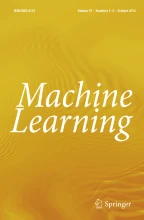Abstract
Explanation-based learning depends on having an explanation on which to base generalization. Thus, a system with an incomplete or intractable domain theory cannot use this method to learn from every precedent. However, in such cases the system need not resort to purely empirical generalization methods, because it may already know almost everything required to explain the precedent. Learning by failing to explain is a method that uses current knowledge to prune the well-understood portions of complex precedents (and rules) so that what remains may be conjectured as a new rule. This paper describes precedent analysis, partial explanation of a precedent (or rule) to isolate the new technique(s) it embodies, and rule reanalysis, which involves analyzing old rules in terms of new rules to obtain a more general set. The algorithms PA, PA-RR, and PA-RR-GW implement these ideas in the domains of digital circuit design and simplified gear design.
Article PDF
Similar content being viewed by others
Explore related subjects
Discover the latest articles, news and stories from top researchers in related subjects.Avoid common mistakes on your manuscript.
References
Anderson, J.R.(1977).Induction of augmented transition networks.Cognitive Science,1,125–157.
Berwick, R.C.(1985).The acquisition of syntactic knowledge.Cambridge, MA: MIT Press.
Brotsky, D.C.(1984).An algorithm for parsing flow graphs(Technical Report Number AI-TR-704).Cambridge,MA: Massachusetts Institute of Technology,Artificial Intelligence Laboratory.
Darlington, J.(1981).An experimental program transformation and synthesis system.Artificial Intelligence,16,1–46.
DeJong, G., & Mooney, R.(1986).Explanation-based learning:An alternative view.Machine Learning,1, 145–176.
Ellman, T.(1985).Generalizing logic circuit designs by analyzing proofs of correctness.Proceedings of the Ninth International Joint Conference on Artificial Intelligence(pp.643–646).Los Angeles,CA: Morgan Kaufmann.
Fikes, R.E., Hart, P.E., & Nilsson, N.J.(1972).Learning and executing generalized robot plans.Artificial Intelligence,3, 251–288.
Hall, R.J.(1985).On using analogy to learn design grammar rules.Master's thesis,Artificial Intelligence Laboratory,Massachusetts Institute of Technology, Cambridge,MA.
Hall, R.J.(1986a).Learning by failing to explain(Technical Report AI-TR-906).Cambridge,MA: Massachusetts Institute of Technology,Artificial Intelligence Laboratory.
Hall, R.J.(1986b).Learning by failing to explain.Proceedings of the Fifth National Conference on Artificial Intelligence(pp.568–572).Philadelphia, PA: Morgan Kaufmann.
Laird, J.E., Rosenbloom, P.S., & Newell, A.(1984).Towards chunking as a general learning mechanism.Proceedings of the Fourth National Conference on Artificial Intelligence(pp.188–192).Austin,TX: Morgan Kaufmann.
Langley, P., & Carbonell, J.G.(1987).Language acquisition and machine learning.In B. MacWhinney (Ed.),Mechanisms of language acquisition.Hillsdale,NJ: Lawrence Erlbaum.
Lebowitz, M.(1986).Not the path to perdition:The utility of similarity-based learning.Proceedings of the Fifth National Conference on Artificial Intelligence(pp.533–537).Philadelphia,PA: Morgan Kaufmann.
Mahadevan, S.(1985).Verification-based learning:A generalization strategy for inferring problem-reduction methods.Proceedings of the Ninth International Joint Conference on Artificial Intelligence(pp.616–623).Los Angeles,CA: Morgan Kaufmann.
Marcus, M.(1980).A theory of syntactic recognition for natural language.Cambridge,MA: MIT Press.
Michalski, R.S., & Stepp, R.E.(1983).Learning from observation:Conceptual clustering.In R.S. Michalski, J.G. Carbonell, & T.M. Mitchell (Eds.),Machine learning:An artificial intelligence approach.Los Altos, CA: Morgan Kaufmann.
Minton, S.(1985).Selectively generalizing plans for problem-solving.Proceed-ings of the Ninth International Joint Conference on Artificial Intelligence (pp.596–599).Los Angeles,CA: Morgan Kaufmann.
Minton, S., Carbonell, J.G., Etzioni, O., Knoblock, C.A., & Kuokka, D.R. (1987).Acquiring effective search control rules:Explanation-based learn-ing in the PRODIGY system.Proceedings of the Fourth International Workshop on Machine Learning(pp.122–133).Irvine,CA: Morgan Kaufmannhati.
Mitchell, T.M., Keller, R., & Kedar-Cabelli, S.(1986).Explanation-based generalization:A unifying view.Machine Learning,1,47–80.
Mitchell, T.M., Utgoff, P., & Banerji, R.(1983).Learning by experimentation: Acquiring and refining problem-solving heuristics.In R.S. Michalski, J.G. Carbonell, & T.M. Mitchell (Eds.),Machine learning:An artificial intelligence approach.Los Altos,CA: Morgan Kaufmann.
Mooney, R., & Bennett, S.W.(1986).A domain independent explanation-based generalizer.Proceedings of the Fifth National Conference on Artificial Intelligence(pp.551–555).Philadelphia,PA: Morgan Kaufmann.
Mooney, R., & DeJong, G.(1985).Learning schemata for natural language processing.Proceedings of the Ninth International Conference on Artificial Intelligence(pp.681–687).Los Angeles,CA: Morgan Kaufmann.
Pazzani, M., Dyer, M., & Flowers, M.(1986).The role of prior causal theories in generalization.Proceedings of the Fifth National Conference on Artificial Intelligence(pp.545–550).Philadelphia,PA: Morgan Kaufmann.
Ressler, A.L.(1984).A circuit grammar for operational amplifier design (Technical Report AI-TR-807).Cambridge,MA: Massachusetts Institute of Technology,Artificial Intelligence Laboratory.
Rich, C.(1981).A formal representation for plans in the Programmer's Apprentice.Proceedings of the Seventh International Joint Conference on Artificial Intelligence(pp.1044–1052).Vancouver,B.C.,Canada: Morgan Kaufmann.
Steinberg, L., & Mitchell, T.M.(1984).A knowledge based approach to VLSI CAD:The REDESIGN system.Proceedings of the 21st IEEE Design Automation Conference(pp.412–418).Albuquerque,NM: IEEE.
Van Lehn, K.(1987).Learning one subprocedure per lesson.Artificial Intelligence,31,1–40.
Wills, L.M.(1987).Automated program recognition(Technical Report AI-TR-904).Cambridge,MA: Massachusetts Institute of Technology,Artificial Intelligence Laboratory.
Winston, P.H.(1975).Learning structural descriptions from examples.In P.H. Winston (Ed.),The psychology of computer vision.New York: McGraw-Hill.
Winston, P.H., Binford, T.O., Katz, B., & Lowry, M.(1983).Learning physical descriptions from functional definitions,examples,and precedents.Proceedings of the Fifth National Conference on Artificial Intelligence(pp.433–439).Washington,DC: Morgan Kaufmann
Author information
Authors and Affiliations
Corresponding author
Rights and permissions
About this article
Cite this article
Hall, R.J. Learning by Failing to Explain: Using Partial Explanations to Learn in Incomplete or Intractable Domains. Machine Learning 3, 45–77 (1988). https://doi.org/10.1023/A:1022685515549
Issue Date:
DOI: https://doi.org/10.1023/A:1022685515549
